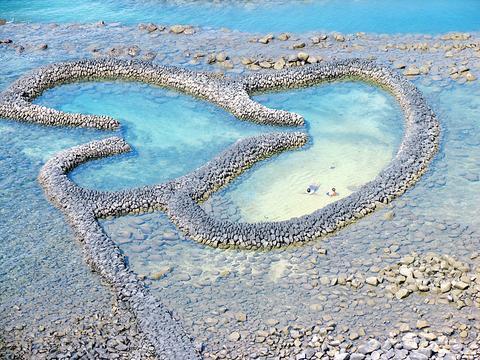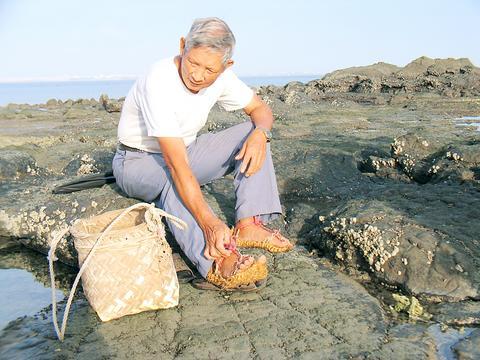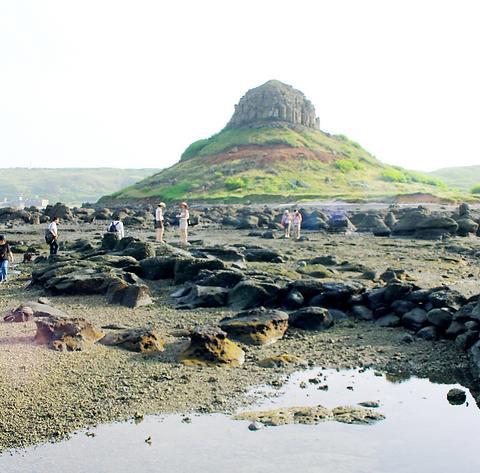Yang Chin-hua
Historians say stone weirs were first built in Penghu 700 years ago. The origins of most aren't known because they were public works; anyone in the community who could lift a rock and wanted to eat had incentive to help with construction. Because they eventually succumb to the tides, they have to be maintained.

PHOTOS: DAVID MOMPHARD, TAIPEI TIMES
But to call folks like Yang fishermen isn't entirely correct. Penghu's traditional lifestyle was equal time spent catching fish (often building a weir to catch more) and time spent coaxing crops out of infertile soil.

In farming, too, they built walls. On every island in the archipelago where crops have been cultivated, locals have stacked coral to protect their plants from the fierce winds that scour the archipelago in the winter months. Kilometers of meter-high walls crisscross the islands in a honeycomb pattern that is as pleasant to look at as it is practical.
But the stone weirs that trap fish have captured people's fancy, as well; none more than Twin Heart (

Yang's fish trap isn't the tourist trap that Twin Heart is. Mention Twin Heart, and he grimaces.
There are no young couples coming to photograph themselves in front of his fish trap -- there's no birds-eye vantage point from which to get it all in frame. And even if they could, no couple would want to be photographed in front of a fish trap called Cow's Heart (
Yang was out of luck in terms of materials to build his weir, too. Where Twin Heart sits beneath a cliff that has supplied an ample amount of basalt stones for its construction, Yang had to carry stones from the base of Turtle Mountain, a promontory of basalt rising 70m above sea level and hundreds of meters to the west. He used large pieces of coral in building it, as well, but said the heavier basalt didn't wash away as easily in the tide.
Yang started work on the project as a boy, helping his dad. A half-dozen able-bodied young locals who agreed to work for a share in the spoils joined them. The group piled stones by hand, one stone at a time, across an area the size of a football field. It took the better part of a decade.
How many fish does it catch in an average tide?
"Oh, maybe none. Not many," Yang said. "Fewer than it used to."
Though they've brought Yang his dinner all his life, the tides have slowly changed for Penghu. For the first half-century of Yang's life, his native Hsiyu was, in effect, more of an island than it is now. In the late 1970s, bridges connected it to Baisha and Matsu islands, making the three, in effect, one large island. About the same time, commercial air flights connected them to Taiwan proper. Then everyone left for paid work and a more modern lifestyle. Yang figures the folks that helped him stack his stone trap were among them.
"I haven't seen them here in a while," he said.

That US assistance was a model for Taiwan’s spectacular development success was early recognized by policymakers and analysts. In a report to the US Congress for the fiscal year 1962, former President John F. Kennedy noted Taiwan’s “rapid economic growth,” was “producing a substantial net gain in living.” Kennedy had a stake in Taiwan’s achievements and the US’ official development assistance (ODA) in general: In September 1961, his entreaty to make the 1960s a “decade of development,” and an accompanying proposal for dedicated legislation to this end, had been formalized by congressional passage of the Foreign Assistance Act. Two

March 31 to April 6 On May 13, 1950, National Taiwan University Hospital otolaryngologist Su You-peng (蘇友鵬) was summoned to the director’s office. He thought someone had complained about him practicing the violin at night, but when he entered the room, he knew something was terribly wrong. He saw several burly men who appeared to be government secret agents, and three other resident doctors: internist Hsu Chiang (許強), dermatologist Hu Pao-chen (胡寶珍) and ophthalmologist Hu Hsin-lin (胡鑫麟). They were handcuffed, herded onto two jeeps and taken to the Secrecy Bureau (保密局) for questioning. Su was still in his doctor’s robes at

Last week the Democratic Progressive Party (DPP) said that the budget cuts voted for by the China-aligned parties in the legislature, are intended to force the DPP to hike electricity rates. The public would then blame it for the rate hike. It’s fairly clear that the first part of that is correct. Slashing the budget of state-run Taiwan Power Co (Taipower, 台電) is a move intended to cause discontent with the DPP when electricity rates go up. Taipower’s debt, NT$422.9 billion (US$12.78 billion), is one of the numerous permanent crises created by the nation’s construction-industrial state and the developmentalist mentality it

Experts say that the devastating earthquake in Myanmar on Friday was likely the strongest to hit the country in decades, with disaster modeling suggesting thousands could be dead. Automatic assessments from the US Geological Survey (USGS) said the shallow 7.7-magnitude quake northwest of the central Myanmar city of Sagaing triggered a red alert for shaking-related fatalities and economic losses. “High casualties and extensive damage are probable and the disaster is likely widespread,” it said, locating the epicentre near the central Myanmar city of Mandalay, home to more than a million people. Myanmar’s ruling junta said on Saturday morning that the number killed had